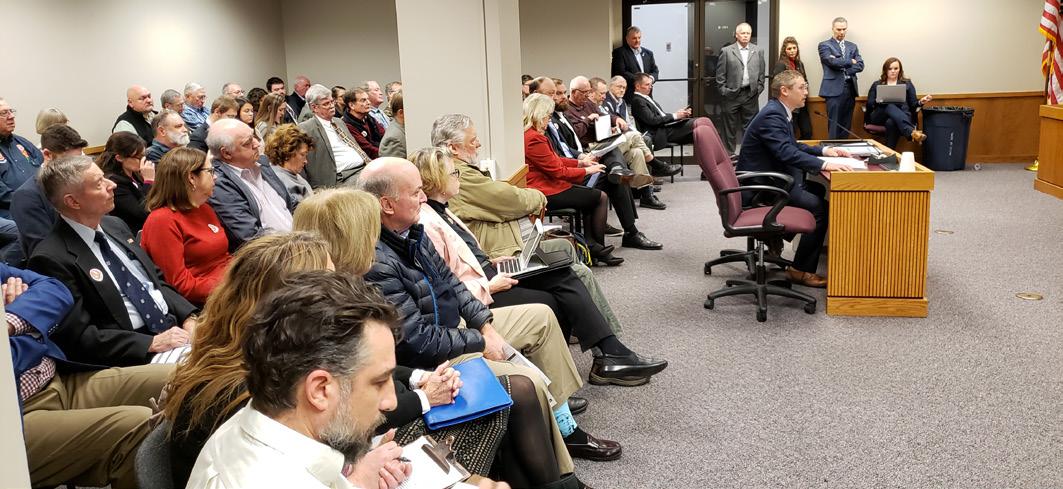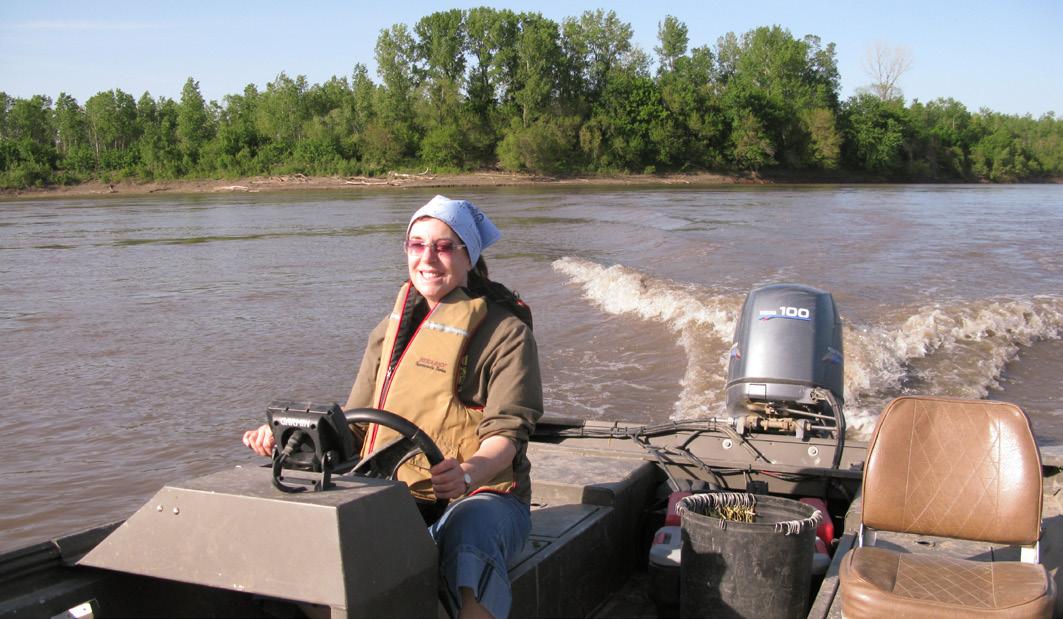
16 minute read
Columbia Event Flyer
Pull for Conservation: Central, Aiming at a New Location
This summer’s event is scheduled to take place at the Prairie Grove Shooting facility northeast of Columbia on August 29th.
The Conservation Federation of Missouri (CFM) is excited to announce that we are exploring a partnership between our “Pull For Conservation” activities and two organizations that are focused primarily on introducing youth to the shooting sports. They are the 4-H Shooting Sports Program and the Missouri Youth Sport Shooting Alliance (MYSSA).
Both organizations are statewide in scope and are on a mission that dovetails perfectly with that of the Conservation Federation – assuring that the next generation and its leadership are passionately committed to the conservation cause. The shooting sports are perfect activities that position participants to gain an appreciation for how conservation and outdoor activities add to one’s quality of life.
Committee members Norm Stucky and Tom Russell, have met with Dr. David Vaught, Executive Director of MYSSA and Jim Sappington, Executive Director of the Missouri 4-H program to begin exploring how a partnership could be a win-win for everyone. The meetings have been very productive, and all participants are enthusiastic about what the future may hold for such a partnership.
For many years, CFM has given high priority to passing the “Conservation Baton” down to the next generation. The Conservation Leadership Corps and support for the National Archery in Schools Program are two prime examples. We believe that now is the time to expand our scope and support MYSSA and the 4-H shooting sports program.
Lending a hand at our “Pull for Conservation” events is an obvious way that youth from these organizations could make a positive contribution to CFM. One way to express appreciation for such help would be to utilize CFMs media contacts to promote these two organizations and their shooting sports programs.
This years Pull for Conservation will be engaging more youth at the new location at Prairie Grove Shooting Sports near Columbia. (Photo: Courtesy of CFM)
Helping the young people understand CFM’s role of being a “Voice for Missouri Outdoors” would be another important goal. In particular, working with our elected officials and gaining an understanding of how the “stroke of a pen” legislatively can have a profound impact on the conservation cause.
We further believe that acquainting these youth with our Conservation Leadership Corps could yield major dividends. Very likely some would be inspired and choose to become part of a program that focuses on developing tomorrow’s conservation leaders.
Other ideas will no doubt emerge as discussions continue. The key point being that in this day of electronics, young people are spending untold hours on e-devices. We must look for and seize every opportunity to encourage them to get outdoors and understand the importance of conservation.
CFM Leadership and staff are hopeful that the COVID-19 pandemic is in the rear-view mirror by August 29th when this emerging partnership could be on display at the 14th annual Central Missouri “Pull for Conservation” event. Please make plans to spend the day with us at this one-of-a-kind shooting facility.
Norm Stucky
2020 Legislative Report: The Good, the Bad, and the Ugly
To say this year’s legislative session was exciting, would be an understatement. The 2020 session of the Missouri Legislature ended on Friday, May 15th. Although the state closed for several weeks, the Senate and House of Representatives managed to pass around fifty pieces of legislation including the state budget. If you have been following our Legislative Action Center (LAC), we sent out several calls to action to oppose or support key conservation legislation this session. Together we defeated over 75 bills that were on our radar this session, so we have a lot to be proud of.
The Good
House Bill 1711, affectionately labeled “The Snack Stick Bill,” was one of the few pieces of legislation to pass out of the Missouri Legislature this session. This bill ultimately changed one word from CFM’s previous Share the Harvest (STH) bill to include shelf-stable venison to be utilized as protein in weekend meal programs at public schools like Buddy Packs. It passed the House unanimously 159-0 and passed the Senate 29-1.
Through an amazing showing of united Missouri conservationists, House Joint Resolution 100 (HJR 100), was defeated. The plan of this resolution would be to reign in the Missouri Department of Conservation (MDC) and place its rule making authority under the House Joint Committee on Administrative rules or JCAR. For the last 85 years, Missourians have repeatedly voiced their stance that politics should stay out of conservation. Because of that, the Missouri Model of Conservation continues to be the template for the rest of the Nation. Thank you to the all dedicated outdoorsmen and women who opposed HJR 100 by testifying at the capitol, contacting their representatives, and communicating the importance of this piece of legislation to their friends and family.
Multiple attempts to sell off the Eleven Point River State Park were halted. Even though House Bill 2635 was defeated, further attempts were made to add the intentions of the bill as amendments to other pieces of legislation. Those too were defeated by CFM, our affiliates, and our allies.

Citizens packed the room to oppose HJR 100 this past legislative session to oppose this bill, which was defeated. (Photo: Courtesy of CFM)
The Bad
CFM supported House Bill 1547 and Senate Bill 661 relating to laws surrounding prescribed burning. These bills would have specified that any landowner or their agent would not be liable for damage caused by a prescribed burn unless the landowner was shown to be negligent. After discussions with other groups, language in the bill needed to be rewritten and failed to make final passage. We will continue to work on getting this one passed next session.
The Ugly
For nearly thirty years, CFM has administered the Share the Harvest program assisting hunters in donating thousands of pounds of venison to Missourians in need. An amendment was filed by Rep. Robert Ross to the MDC budget to remove the funding for Operation Game Thief and an attempt to divert STH funds from coming to CFM from MDC. At the time of this writing, many of the details of this line-item are yet to be determined. One thing is certain, Share the Harvest is CFM’s program, and it is not going anywhere.
Thank you to our Members, Affiliates, Board of Directors, and to everyone who contacted their legislators through the Legislative Action Center or otherwise. Our wildlife, natural resources, and outdoor heritage need you as their primary line of defense. We are grateful to all of you for your continued commitment to conservation in Missouri.
Kyna Iman & CFM Staff


First Fishing License

The rain was coming down hard and I was at work staring at the computer. My new boat was in the garage dry and comfortable because everything else that used to be in the garage was now outside getting wet. I suppose boats are designed to get wet, but I liked to keep mine out of the rain since it was only a few months old. I knew the rain was going to make the Missouri River rise, and the catfish should be biting. There I was stuck at work while perfect fishing conditions were developing outside. With all these thoughts swirling in my mind, I again checked the weather forecast on my computer at work and saw a short dry spell between significant storms. I could not stand it anymore and abandoned my office, taking the rest of the day off for a higher purpose. When I got home, Mrs. Urich was watching the TV weather radar. It looked terrible, but there was a small clear spot over central Missouri, so I decided to chance it.
Then she announced that she was going with me. I couldn’t believe it. She had never gone fishing with me, had never been in the new boat or any boat for that matter, and doesn’t like to be outside in bad weather. She insisted because she wanted to keep me safe. This was strange because she had watched unconcerned for years as I disappeared into atrocious weather without concern, especially if I was going outside to feed her horses. Maybe I should have been pleased that she was concerned about my well-being. I quickly rounded up some rain gear and we headed to the bait shop to purchase the first fishing license of her life.
We launched the boat into the Missouri River just as the rain intensified. Mrs. Urich had to face the back of the boat because the wind was driving the raindrops into her skin and eyeballs. It felt like pinpricks as the boat gained speed. Her first Missouri River boating adventure was rapidly turning to the dark side.
I wanted to get down the river and back to the boat access before the lightning started. I don’t mind being in a boat during the rain, but there is something uncomfortable about sitting in a metal boat in the water with lightning flashing overhead.
The rain suddenly stopped, and we had a breather. There were more looming, dark storm clouds coming from the west. There was no way I could get out five trotlines before the next round of storms would catch us. It was apparent that Mrs. Urich had to step up and be helpful by driving the boat and her duties as Safety Officer even though this was her first boating experience.
I reminded her that she was with me to keep me safe, and now was her chance. I gave her a 90-second Cliff Notes boat driving lesson. Then she got one practice session nosing the boat carefully up to a rock wing dike without crushing the boat or flipping me off the bow. She passed and took the controls. Less than an hour later we were loading the boat back onto the trailer just as the rain, hail, and lightning began in earnest. She had succeeded in keeping me safe. Good wife.
Mrs. Urich was curious enough about the trotlines that she went with me the next morning to see what we caught. The weather was much improved. Plus, she wanted to drive the boat again since she thought it was fun, and she felt safer handling the controls herself. We managed to catch some nice catfish and it was the first time she had seen a bluecat or flathead catfish.

She was impressed with their size and the almost prehistoric appearance of the flathead. Although she was getting pretty good at handling the boat, she declined lessons on cleaning fish. She felt her skills would be better utilized sitting in the boat’s command chair, supervising the effort.
Since then, we have gone fishing together many times on the Missouri River. Mrs. Urich always drives the boat and she is very good at it now. She naturally gravitates to a position of command and authority no matter where she is, so driving the boat suited her. Even when I take my new-boat-mooching friends out, they all know that Mrs. Urich will drive and respectfully defer to her.
Most importantly, she has learned to back the truck and boat down the boat ramp, if I have it positioned for her at the top of the ramp. This is very convenient and makes launching the boat much easier. However, Mrs. Urich has more trouble backing the empty trailer down the ramp. We practiced several times in a parking lot, but I realized that our long and mostly happy marriage was not going to withstand too many trailer backing lessons. We will have to work on this skill slowly.
My little voice, who resides in the back of my mind and tries desperately to save me from myself, was on high alert during these practice sessions urging patience and calmness and suggested the go-slow approach. My little voice reminded me that I had a good thing going here, no sense in blowing it.
David Urich
(Left) David and Mrs. Urich on the deck of the new boat with a successful morning catfish harvest. (Photo: Courtesy of David Urich)
(Right) Mrs. Urich, as an experienced River Rat and boat operator, driving the new boat on the Missouri River. (Photo: Courtesy of David Urich)
Frog Season is Open
Ihave never met a frog I didn't like. Besides, how would you know? Frogs have a limited guttural vocabulary and very little facial recognition. They are certainly not cuddly creatures, although some consider them cute—not sure why.
I had a teacher in high school that reminded me of an old bullfrog on a pond bank. She gave us challenging assignments and then sat at her desk and stared with a pie face and big, round eyes, never blinking or changing expression, like a frog. Her mouth was shaped like a frog too, big and wide with narrow lips.

I once busted out laughing in class while envisioning her flicking a long tongue at a passing fly. The principal was not amused, and I truthfully would have been better off not to admit why I laughed.
Bullfrogs, unlike that teacher, frogs are interesting creatures. Their very design is a miracle of God. They are opportunistic survivalists that occasionally fall to a predator, including raccoons, big birds, snakes or bass and larger frogs return the favor. Their diet might surprise you.
Frogs are carnivores. Small to medium-sized frogs eat insects such as flies, mosquitoes, moths and dragonflies. Larger frogs will eat larger insects like grasshoppers and worms. Some large frogs will even eat small snakes, mice, baby turtles, and even smaller frogs, which is why they are seldom invited to family dinners.
Bullfrogs typically hibernate underwater. A common misconception is that they spend the winter dug into the mud at the bottom of a pond or lake like turtles. Hibernating frogs would suffocate if they dug into the mud for an extended period.
A hibernating turtle's metabolism slows down so drastically that it can get by on the mud's meager oxygen supply. Hibernating frogs must be near oxygen-rich water and spend a good portion of the winter just lying on top of the mud or only partially buried. They may even slowly swim on occasion, but not far or for very long in icy conditions.
Frogs hide in cover on shorelines and would likely live a lot longer if not for their legs. Visit an expensive restaurant and look at the price of frog legs. There are frog farms where the poor amphibians are raised for their legs. In their society, being weak and sickly may be the chance to survive longer. Healthy frogs with muscular legs are the first to go.
But I have always wondered who was hungry enough to try frog legs for the first time. Sure, I know that frog legs taste good, but so-called civilized people didn't always know that. Besides, the wealthy may think that skunk is remarkable cuisine and only sold in expensive restaurants in 100 years. I wonder who will be the first to try it. Well, someone once tried frog the first time. Can you imagine what the neighbors said?
"Don't look Mary, that idiot is eating a frog again. "Oh, good grief, that ghoul is eating the legs. Turn your head honey, don't look." That adventurous fellow discovered how good frog legs tasted when fried like chicken or fish. Still, many turn their nose up at the very thought of making a frog dinner.
Several decades ago, my brother and I took a batch of frog legs to my employment place. A friend volunteered to bring in a cooker with grease to fry the succulent meat. Almost everyone in the room swore they would never touch anything so disgusting. I finally talked every man into taking just one bite, and that was it. The platter of frog legs disappeared minutes later and every man wanted more.
Frog season starts on sunset June 30th and there are several good methods to harvesting frogs, including grabbing, stabbing or nabbing old Kermit. So, where do you find frog legs? Why attached to the frog, of course, and finding enough to make a good meal may be challenging. Those that prefer to avoid expensive restaurants can try the following methods:
Shooting: I highly recommend that you don't shoot frogs. The problem is, bullets reflect off the water the same as shooting at a rock. I saw a guy's bullet hit his brother in the leg off a ricochet. We were lucky that boy did not get killed.
Stabbing: Buy a trident gig, attach it to an old broom handle and go frog hunting. You can use the flashlight method at night or sneak around in the daytime. Frogs spook easily but sometimes they sit still for easy impalement. I didn't say they were the smartest critters in the pond. Most frog hunters stab them in the back, certainly a dirty deed from any frog's prospective, but a productive way to catch old Kermit.
Grabbing: You won't grab many frogs in the daylight, they are not that dumb. But you can get your legal limit at night, especially when the water is low and mud banks are exposed. Otherwise, frogs stay in the grass making them easy prey for all predators except humans.
Shine your flashlight bean directly into the frog's eyes for a hypnotizing effect. Then quietly paddle up and grab the frog while making sure your hand does not break the light bean, even for a split second. Should your flashlight beam pick up red eyes shining close to the frog, pass up the grab. That is likely a big snake slipping up to eat the same frog. Taking food from a hungry snake makes them angry and happy to deliver a painful bite on your hand or arm.
Red Rags: All country kids know that a frog will bite anything red dangled in front of their face. They will do the same for a well-placed popping bug when you are bluegill or bass fishing with a flyrod. Many simply place a small piece of red material on a hook and go frog hunting. This does require a bit of stealth, so approach your frog haven slowly, and quietly.
There are dozens of ways to prepare frog legs. Google "cooking frog legs" and you will find numerous recipes. We just bread and deep fry frog legs—and that is darned good eating!
Frogging season opens June 30, 2020 and ends October 31, 2020. The bullfrog and green frog limit are eight daily combining both species and a possession of 16 combined species. You are required to have a resident or nonresident fishing permit. Good luck and happy frogging!










